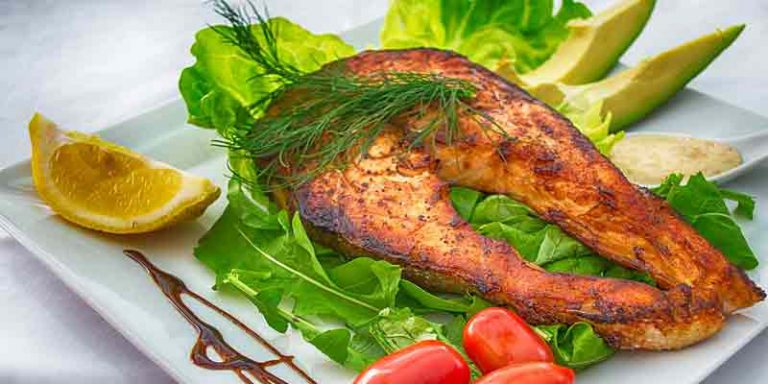Salmon is a popular fish to eat, especially in America. If you’ve cooked some salmon and end up with some leftovers, you may wonder what options you have to store them for later. Would freezing cooked salmon be an option?
Can you freeze cooked salmon? Yes, you can freeze cooked salmon. Whether it’s fried, baked, grilled, or smoked salmon, you can freeze them without any issues. To ensure that the cooked salmon retain their texture and flavor, wrap them tightly in aluminum foil and place them into a freezer bag before freezing them. Properly stored, cooked salmon will last for 6 months in the freezer.
Does Cooked Salmon Freeze Well?
Cooked salmon freeze extremely well if it’s properly stored. Like most other food, salmon will lose its flavor and texture when frozen, whether it’s fresh or cooked.
Therefore, I recommend wrapping them in aluminum foil and then in a freezer bag. This will ensure that air has a small chance of reaching the cooked salmon.
How To Freeze Cooked Salmon
Step 1: Allow To Cool Down
Once the salmon is cooked, allow it to cool down to room temperature before freezing.
Avoid freezing the salmon when it’s still warm. The warmth of the salmon will cause condensation in the storage container. The moisture from the condensation will damage the fish.
Allow it to cool on the countertop for about 1 hour.
Also, avoid leaving the salmon at room temperature for longer than 2 hours. This will allow harmful bacteria to grow on the fish. After it’s cooled, immediately freeze the fish.
Step 2: Slicing
Once the salmon has cooled completely, slice the fish into portions. This will make it easier for you to freeze and thaw them.
Also, it will prevent you from having to thaw the entire fish. You cannot freeze any leftovers.
Step 3: Wrapping
Wrap each slice of the salmon individually with cling film or aluminum foil.
After it’s wrapped, double-check for any tears on the wrap. Just a small amount of air that leaks in can destroy the fish.
Step 4: Place Into Freezer Bags
Place each individually wrapped salmon into the freezer bag. You can place a couple of pieces in each bag.
After all the salmon are in the bag, press on it to remove any excess air before sealing it.
Step 5: Label and Freeze
With a marker, write the date of freezing and content on the freezer bag. Then place them into the freezer for storage.
How Long Can You Freeze Cooked Salmon?
Cooked salmon can freeze for approximately six months in the freezer. The fish will need to be stored properly to ensure they remain fresh for that long.
After 6 months, cooked salmon will start to deteriorate in quality. Every month that’s the salmon is still frozen, the more the texture and taste will decrease.
However, after that time, cooked salmon will still be safe to eat though. The only thing is that it will not taste as fresh as it should.
How Do You Defrost Cooked Salmon?
The best way to defrost cooked salmon is in the fridge. This will allow the salmon to thaw with little or no changes to their texture and taste.
Remove the salmon from the freezer and place it onto a plate. Keep the fish in their packaging and let it sit in the fridge overnight or for at least 6 hours.
After it has thawed, you can leave the salmon in the fridge for up to 48 hours. After that time, you’ll need to throw it out.
Can You Refreeze Cooked Salmon?
I would advise against refreezing cooked salmon. After the initial freezing and thawing, the salmon has already lost some of its flavors.
By freezing them once more, the salmon will deteriorate even more.
After thawing the cooked salmon for the second time, you will notice the fish has lost most of its flavor.
To prevent refreezing cooked salmon, you should portion before freezing. This way, you will only need to remove what you need from the freezer without having to refreeze any leftovers.
How To Reheat Cooked Salmon
Once the salmon has thawed, you have several options to reheat the fish.
Below are the methods that you can try:
Microwave
We don’t recommend that cooked salmon be reheated in the microwave. It will cause the texture and flavor to change. However, if you don’t have a lot of time and really must use the microwave, you’ll need to be extra careful.
Place the fish onto a microwave-safe plate and cover it with a lid and place it into the microwave. Set to the lowest power setting, about 3- to 40 percent of its full power.
Next, microwave the fish in short 30 seconds spurts. Every 30 seconds, flip the fish over. Repeat the process until the salmon is heated all the way through.
Toaster Oven
Like the larger oven, a toaster oven works well in reheating cooked salmon.
Unlike the microwave, the toaster oven will provide even heating throughout.
Wrap the fish in aluminum foil and place it into the toaster oven. Then set the temperature between 275 or 350 F. Check the fish every 10 minutes until it’s heated.
Oven
Preheat the oven to between 275 and 350 F. Place the salmon onto a tray and transfer it to the oven.
Reheat the salmon for about 10 minutes. Check every 3 minutes to see it’s warm throughout.
Skillet
If the smell of the fish doesn’t seem to bother you, using a skillet to reheat the salmon is another option.
In a skillet, heat the skillet on low. Then add olive oil and fry the salmon.
Cover the skillet with a lid and check it every 3 minutes to ensure the salmon is heating evenly throughout. Also, flip the fish to keep it from flaking. Your salmon should be ready in about 5-6 minutes.

